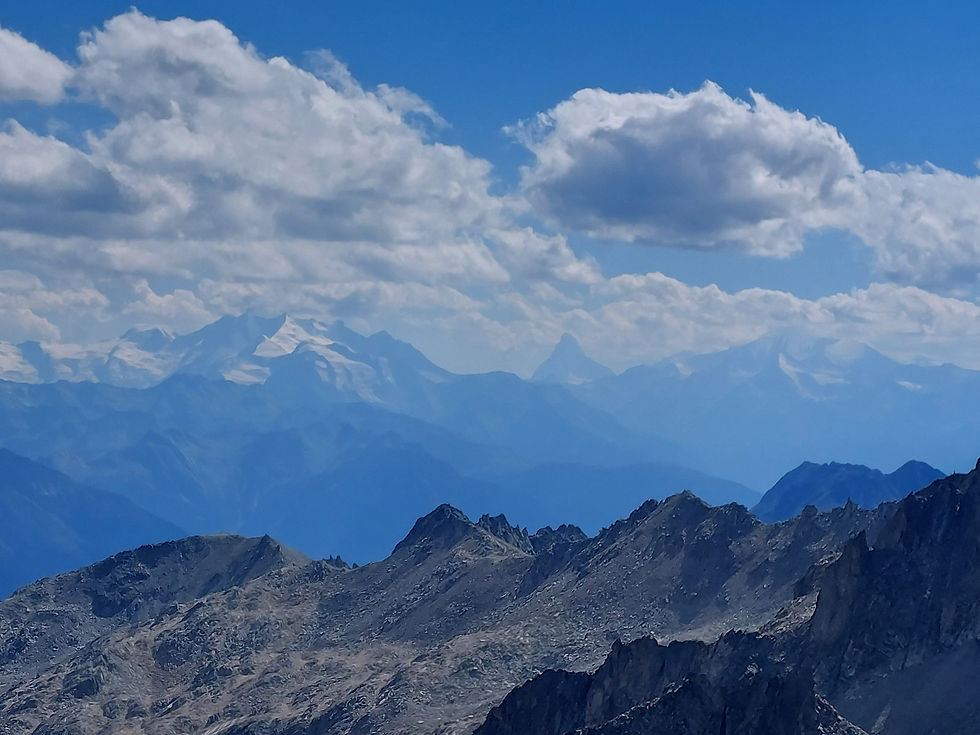A pocket inside of a pocket.
- Levin
- Apr 11, 2024
- 3 min read

Sometimes it's not even necessary to reach the most remote places to find a pocket. In the lower right corner of this old pocket, which must be at least 50 years old, the rock has loosened slightly due to weathering, revealing another small pocket.

At first, it only appeared as a small fissure, no larger than 2cm, but with the "Hägli" (tool for crystal hunting), we were able to fish out a few small smoky quartz points. On this day, I was out with my sister, and my sole goal was to find a few points for her, as she once complained that we never find anything when she's around. Then, I began carefully removing the ceiling with a hammer and chisel. To our luck, it was overgrown, and thus we were even able to retrieve a small cluster of smoky quartz.
However, since I only considered the spot to be a small crevice and we were already satisfied with the few smoky quartz clusters, we continued on. I wanted to explore the surroundings a bit more.

In the evening, while analyzing the pictures, we suddenly noticed that the rock in the back looked like a pocket lid. At the next opportunity, my father and I (my sister didn't want to make the ascent again) set out to the spot again, this time with better tools and a simple idea: to remove the approximately 1.5m long pocket lid and find a pocket underneath.
At the beginning, this plan was still relatively simple, as the rock there was still brittle and the lid was only about 15cm thick. And indeed, the gap and the crystals soon became larger. Again and again, we were able to fish out individual points up to 8cm long from the clay. But unfortunately, it stayed that way for a long time. Countless individual points are stuck in the clay, but not a single cluster or a few connected crystals. Most likely, the crystals were broken apart by the ice.
Our last hope was that deeper inside the rock, the crystals remained intact. The next day, I set out to the pocket once again. One last attempt to reach into the inner rock and remove the pocket lid completely. So far, we've removed about 50cm of the pocket lid, but now it started to become really hard and thicker. My day consisted of painstakingly removing a few centimeters of granite and fishing out a few crystals again and again. Normally, I wouldn't have even attempted to quarry such hard rock, but the crystals that occasionally emerged spurred me on.

After many hours of work, my perseverance finally paid off. I was able to retrieve some groups of smoky quartz with points up to finger length. Two of them even made it into the display case.
A beautiful specimen was still stuck in the clay. I couldn't take it out that day because the opening needed to be enlarged further to retrieve it undamaged. With a heavy backpack, I eventually made my way back down to the valley.
On the third day, once again with my father, we resumed our work. We further chiseled away at the pocket lid until there was enough space to safely extract the specimen.
The specimen didn't disappoint. A cluster with long, slender points, all intact, emerged from the chlorite clay. Another addition for the display case.
The pocket clay was still very thick and seemed to never end, but with the clusters, we were done for now. Single points still occasionally stuck in the clay, but not as frequently as before. The pocket seemed to come to an end. However, suddenly, the pocket at the very back grew much larger. The cavity doubled in height. However, it soon revealed itself to be an illusion. While the cavity was still filled with pocket clay, there were no more crystals. The quartz vein was too small for the pocket. Then it was time to pack up and head back to the valley. Despite the slight disappointment at the end, the pocket was an unexpected success. Sometimes, it pays off to take a closer look, even at an old pocket.



Comments